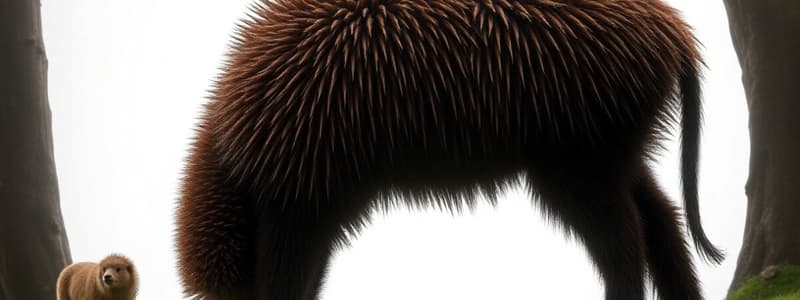Podcast
Questions and Answers
What is the primary characteristic of mechanical isolation in reproductive barriers?
What is the primary characteristic of mechanical isolation in reproductive barriers?
- Failure to recognize mating behaviors
- Different mating seasons between species
- Morphological differences in reproductive organs (correct)
- Genetic incompatibility between hybrid offspring
Which of the following describes temporal isolation?
Which of the following describes temporal isolation?
- Species mate at different times, preventing reproduction (correct)
- Species fail to recognize each other's mating calls
- Physical barriers prevent mating between species
- Hybrids have lower viability than parental species
Which example best illustrates hybrid infertility?
Which example best illustrates hybrid infertility?
- Two species of frogs mate but produce no offspring
- Plants that cannot pollinate each other due to structural differences
- Corals that release gametes at different times
- Mules, which are sterile due to different chromosome numbers (correct)
How does low hybrid zygote viability affect species populations?
How does low hybrid zygote viability affect species populations?
What is the primary advantage of prezygotic mechanisms in natural selection?
What is the primary advantage of prezygotic mechanisms in natural selection?
What type of speciation occurs when a population is separated by a physical barrier?
What type of speciation occurs when a population is separated by a physical barrier?
What is a key factor in sympatric speciation that drives reproductive isolation?
What is a key factor in sympatric speciation that drives reproductive isolation?
What prezygotic isolation mechanism involves species that live in different habitats?
What prezygotic isolation mechanism involves species that live in different habitats?
Which of the following best describes gametic isolation?
Which of the following best describes gametic isolation?
What happens if hybrid offspring are less fit than non-hybrids?
What happens if hybrid offspring are less fit than non-hybrids?
Which type of reproductive isolation occurs after mating has taken place but before hybrid offspring can reproduce?
Which type of reproductive isolation occurs after mating has taken place but before hybrid offspring can reproduce?
What is meant by the term 'sister species' in the context of speciation?
What is meant by the term 'sister species' in the context of speciation?
What role does polyploidy play in speciation?
What role does polyploidy play in speciation?
What characterizes allopatric speciation?
What characterizes allopatric speciation?
Which of the following best defines sympatric speciation?
Which of the following best defines sympatric speciation?
Which mechanism prevents fertilization between different species?
Which mechanism prevents fertilization between different species?
What type of mechanism involves the reduced fitness of hybrid offspring after fertilization?
What type of mechanism involves the reduced fitness of hybrid offspring after fertilization?
Which of the following is an example of a postzygotic barrier?
Which of the following is an example of a postzygotic barrier?
What impacts hybrid fitness most directly?
What impacts hybrid fitness most directly?
Which statement describes hybrid sterility?
Which statement describes hybrid sterility?
Which of these is NOT considered a prezygotic reproductive barrier?
Which of these is NOT considered a prezygotic reproductive barrier?
Flashcards are hidden until you start studying
Study Notes
Prezygotic Reproductive Isolation Mechanisms
- Geographic Isolation: Identical to allopatric speciation; populations physically separated by a barrier, leading to divergence.
- Habitat Isolation: Species or populations prefer different habitats, even if in the same geographic location, limiting their chances of interacting.
- Example: Dung beetles specialize in specific feces types.
- Example: Tigers and lions prefer distinct habitats.
- Gametic Isolation: Prevents fertilization despite physical proximity, as gametes are chemically incompatible.
- Example: Sea urchins release sperm & egg cells into the water, relying on gametic isolation to prevent cross-species fertilization.
- Mechanical Isolation: Morphological differences in reproductive structures prevent successful mating.
- Example: Dragonflies exhibit significant variation in genitalia among species.
- Example: Plant structures can restrict pollination from specific species.
- Temporal Isolation: Different breeding seasons or times of day create reproductive isolation for closely related species.
- Example: Coral species living near each other may release gametes at different times of the day.
- Behavioral Isolation: Individuals reject or fail to recognize the mating behaviors of other species.
- Example: Bird mating patterns exhibit species-specific and recognizable behaviors.
Postzygotic Reproductive Barriers
- Low Hybrid Zygote Viability: Hybrid zygotes do not survive, often failing to develop.
- Example: Sheep and goats can breed in labs, but not in natural populations, and the zygote usually fails to develop.
- Low Hybrid Adult Viability: Hybrids may survive to adulthood but experience developmental abnormalities, leading to reduced survival chances.
- Hybrid Infertility: Hybrids can reach adulthood but are infertile.
- Example: Mules, resulting from donkey and horse breeding, are sterile due to chromosomal differences.
Pre vs. Post-zygotic Isolation
- Prezygotic isolation is preferred by natural selection: It prevents wasteful expenditure of energy and resources on unsuccessful mating attempts.
- Postzygotic isolation is less efficient as resources are wasted on hybrids with reduced fitness.
Genetic Incompatibility
- When lineages diverge, they accumulate new alleles at different loci.
- These new alleles may not be compatible with each other, resulting in the hybrid offspring having reduced fitness.
Speciation
- Allopatric Speciation: Physical barriers separating populations lead to divergence and speciation.
- Sister species (closest relatives) often occupy opposite sides of geographic barriers.
- Sympatric Speciation: Speciation without physical isolation.
- Disruptive Selection: Individuals with specific genotypes prefer distinct microhabitats within the same environment.
- Polyploidy: Gene duplications (often in plants) can result in reproductively isolated offspring.
Secondary Contact and Reproductive Isolation
- When previously isolated species come back into contact after allopatric speciation, reproductive isolation can:
- Reinforce: Selection favors non-hybridization due to the reduced fitness of hybrid offspring.
- Be incomplete: Hybrids can still form, but they may exhibit reduced fitness.
Studying That Suits You
Use AI to generate personalized quizzes and flashcards to suit your learning preferences.




